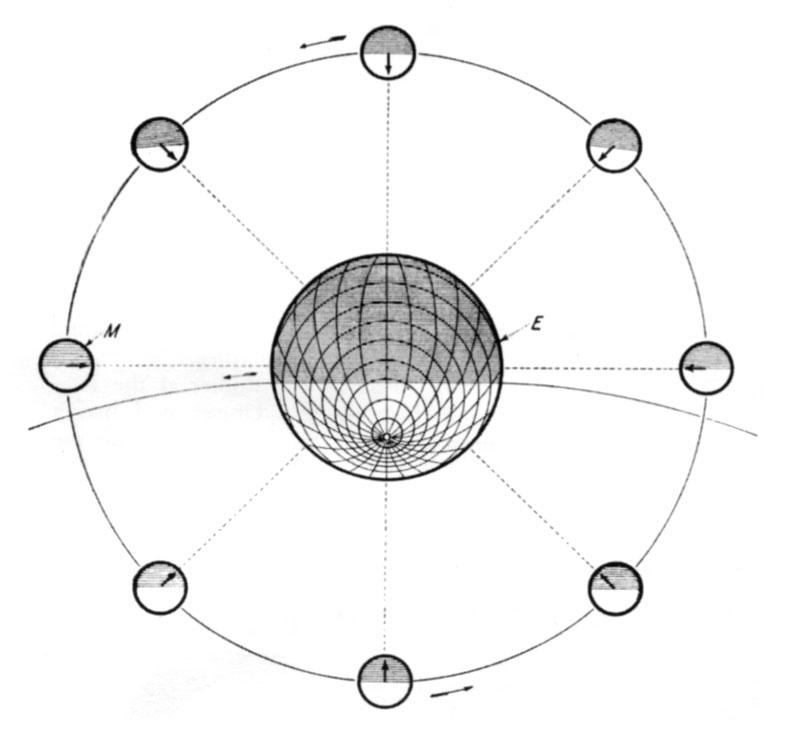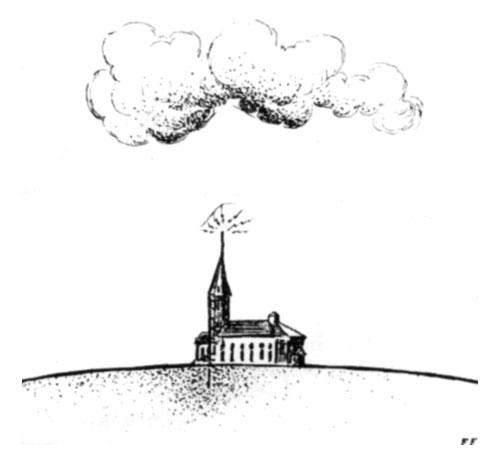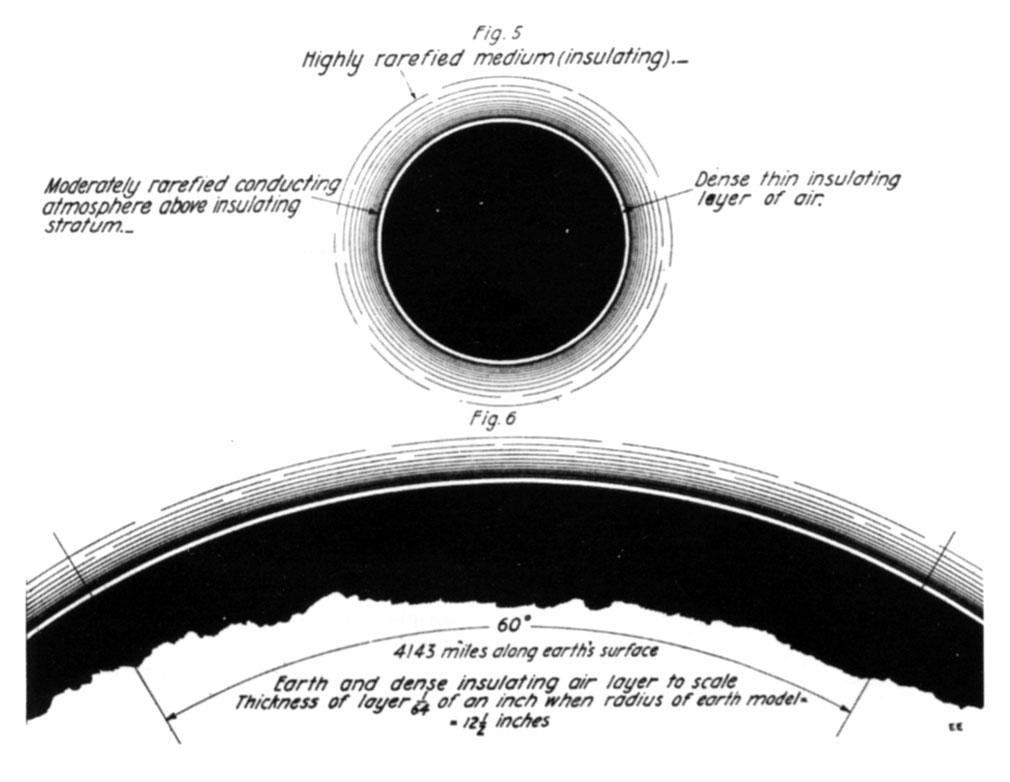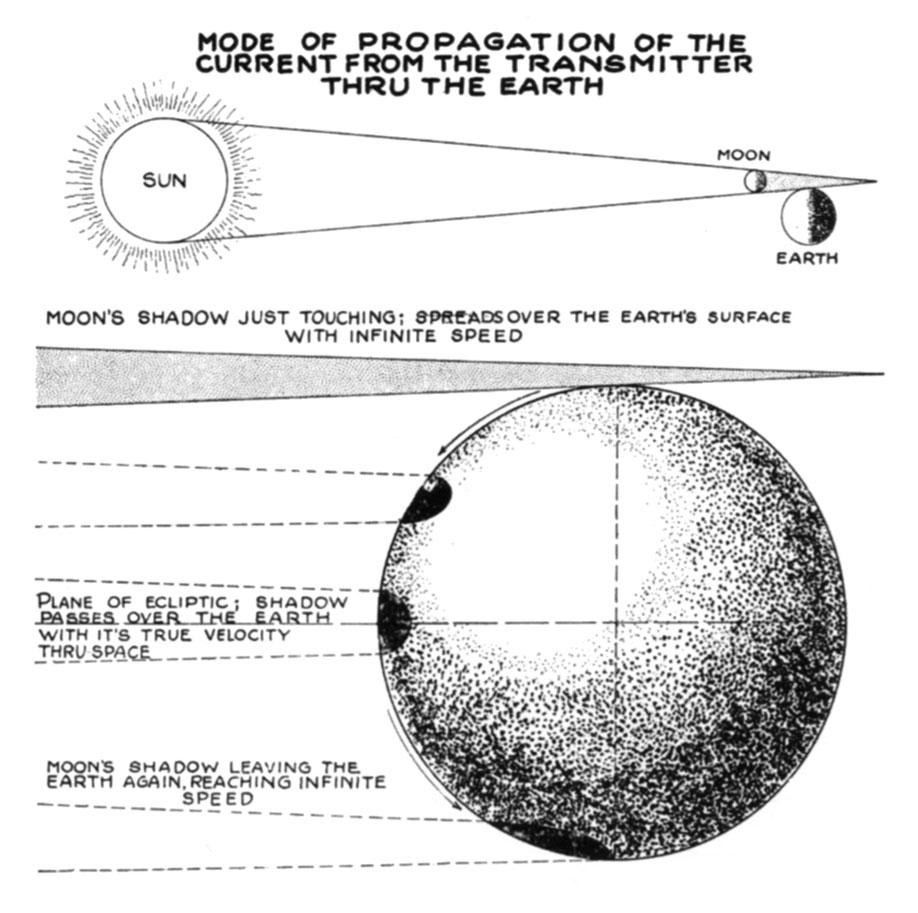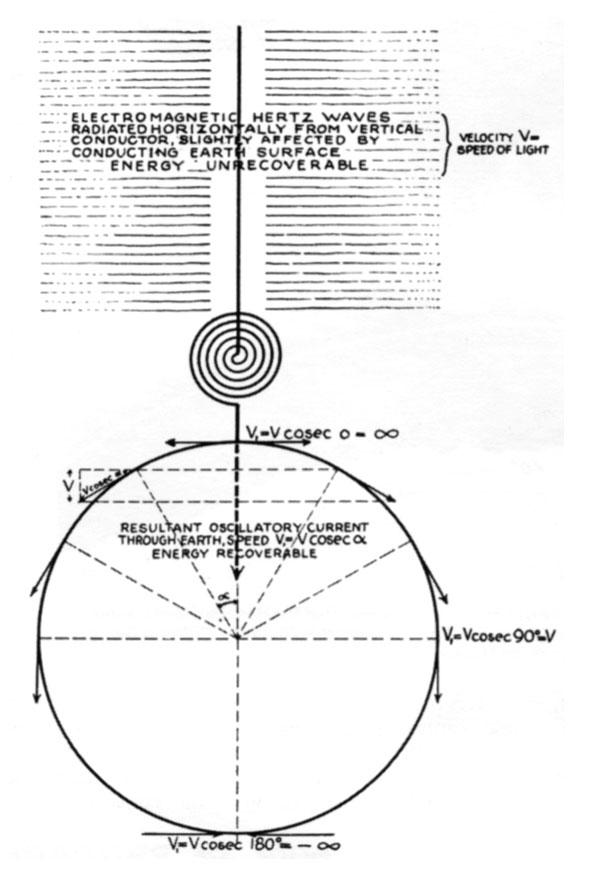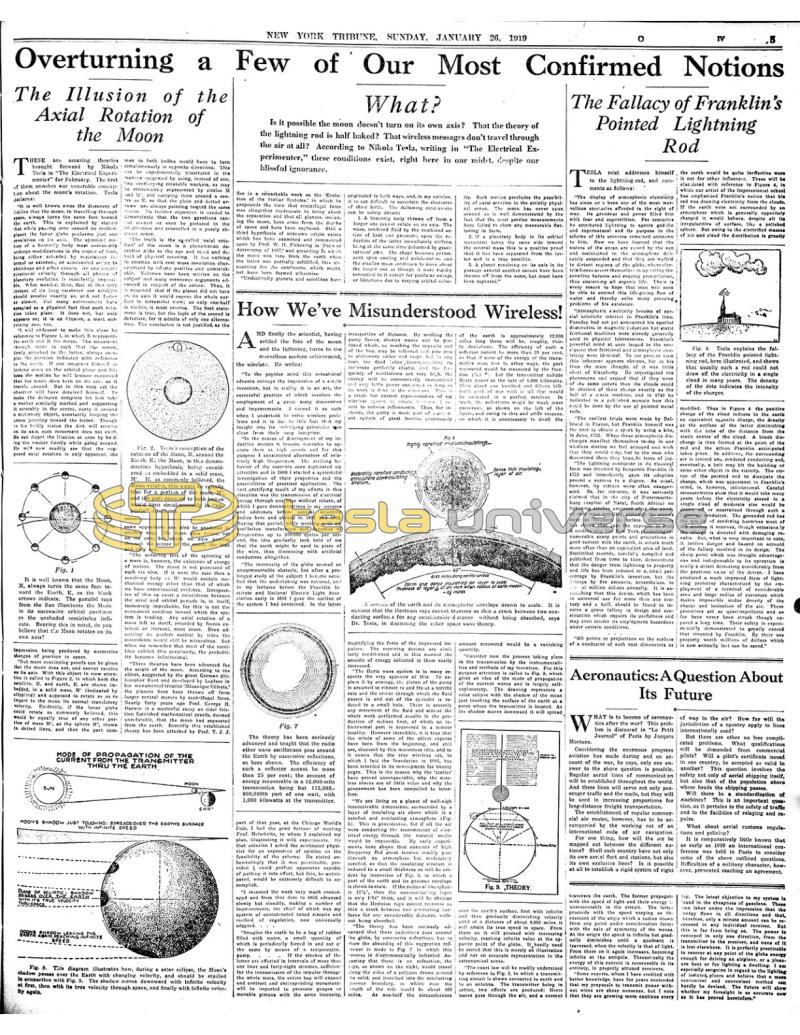
Nikola Tesla Articles
Overturning a Few of Our Most Confirmed Notions
What?
Is it possible the moon doesn't turn on its own axis? That the theory of the lightning rod is half baked. The wireless messages don't travel through the air at all? According to Nikola Tesla, writing in "The Electrical Experimenter," these conditions exist, right here in our midst, despite our blissful ignorance.
The Illusion of the Axial Rotation of the Moon
These are amazing theories brought forward by Nikola Tesla in "The Electrical Experimenter" for February. The first of them smashes our venerable conception about the moon's rotation. Tesla declares:
“I will endeavor to make this clear by reference to Fig. 1, in which E represents the earth and M the moon. The movement thru space is such that the arrow, firmly attached to the latter, always occupies the position indicated with reference to the earth. If one imagines himself as looking down on the orbital plane and follows the motion he will become convinced that the moon does turn on its axis as it travels around. But in this very act the observer will have deceived himself. To make the delusion complete let him take a washer similarly marked and supporting it rotatably in the center, carry it around a stationary object, constantly keeping the arrow pointing towards the latter. Tho to his bodily vision the disk will revolve on its axis, such movement does not exist. He can dispel the illusion at once by holding the washer fixedly while going around. He will now readily see that the supposed axial rotation is only apparent, the impression being produced by successive changes of position in space.
“The truth is, the so-called ‘axial rotation’ of the moon is a phenomenon deceptive alike to the eye and mind and devoid of physical meaning. It has nothing in common with real mass revolution characterized by effects positive and unmistakable. Volumes have been written on the subject and many erroneous arguments advanced in support of the notion. Thus, it is reasoned, that if the planet did not turn on its axis it would expose the whole surface to terrestrial view; as only one-half is visible, it must revolve. The first statement is true but the logic of the second is defective, for it admits of only one alternative. The conclusion is not justified as the same appearance can also be produced in another way. The moon does rotate, not on its own, but about an axis passing thru the center of the earth, the true and only one.
“The unfailing test of the spinning of a mass is, however, the existence of energy of motion. The moon is not possest of such vis viva. If it were the case then a revolving body as M1 would contain mechanical energy other than that of which we have experimental evidence. Irrespective of this so exact a coincidence between the axial and orbital periods is, in itself, immensely improbable for this is not the permanent condition towards which the system is tending. Any axial rotation of a mass left to itself, retarded by forces external or internal, must cease. Even admitting its perfect control by tides the coincidence would still be miraculous. But when we remember that most of the satellites exhibit this peculiarity, the probability becomes infinitestimal.
“Three theories have been advanced for the origin of the moon. According to the oldest suggested by the great German philosopher Kant, and developed by Laplace in his monumental treatise ‘Mécanique Céleste,’ the planets have been thrown off from larger central masses by centrifugal force. Nearly forty years ago Prof. George H. Darwin in a masterful essay on tidal friction furnished mathematical proofs, deemed unrefutable, that the moon had separated from the earth. Recently this established theory has been attacked by Prof. T. J. J. See in a remarkable work on the ‘Evolution of the Stellar Systems,’ in which he propounds the view that centrifugal force was altogether inadequate to bring about the separation and that all planets, including the moon, have come from the depths of space and have been captured. Still a third hypothesis of unknown origin exists which has been examined and commented upon by Prof. W. H. Pickering in ‘Popular Astronomy of 1907,’ and according to which the moon was torn from the earth when the later was partially solidified, this accounting for the continents which might not have been formed otherwise.
“Undoubtedly planets and satellites have originated in both ways and, in my opinion, it is not difficult to ascertain the character of their birth. The following conclusions can be safely drawn:
- A heavenly body thrown off from a larger one cannot rotate on its axis. The mass, rendered fluid by the combined action of heat and pressure, upon the reduction of the latter immediately stiffens, being at the same time deformed by gravitational pull. The shape becomes permanent upon cooling and solidification and the smaller mass continues to move about the larger one as tho it were rigidly connected to it except for pendular swings or librations due to varying orbital velocity. Such motion precludes the possibility of axial rotation in the strictly physical sense. The moon has never spun around as is well demonstrated by the fact that the most precise measurements have failed to show any measurable flattening in form.
- If a planetary body in its orbital movement turns the same side towards the central mass this is a positive proof that it has been separated from the latter and is a true satellite.
- A planet revolving on its axis in its passage around another cannot have been thrown off from the same but must have been captured.”
The Fallacy of Franklin's Pointed Lightning Rod
Tesla next addresses himself to the lightning rod, and comments as follows:
“Atmospheric electricity became of special scientific interest in Franklin's time. Faraday had not yet announced his epochal discoveries in magnetic induction but static frictional machines were already generally used in physical laboratories. Franklin’s powerful mind at once leaped to the conclusion that frictional and atmospheric electricity were identical. To our present view this inference appears obvious, but in his time the mere thought of it was little short of blasphemy. He investigated the phenomena and argued that if they were of the same nature then the clouds could be drained of their charge exactly as the ball of a static machine, and in 1749 he indicated in a publisht memoir how this could be done by the use of pointed metal rods.
“The earliest trials were made by Dalibrand in France, but Franklin himself was the first to obtain a spark by using a kite, in June, 1752. When these atmospheric discharges manifest themselves today in our wireless station we feel annoyed and wish that they would stop, but to the man who discovered them they brought tears of joy.
“The lightning conductor in its classical form was invented by Benjamin Franklin in 1755 and immediately upon its adoption proved a success to a degree. As usual, however, its virtues were often exaggerated. So, for instance, it was seriously claimed that in the city of Pietermaritzburg (capital of Natal, South Africa) no lightning strokes occurred after the pointed rods were installed, altho the storms were as frequent as before. Experience has shown that just the opposite is true. A modern city like New York, presenting innumerable sharp points and projections in good contact with the earth, is struck much more often than equivalent area of land. Statistical records, carefully compiled and publisht from time to time, demonstrate that the danger from lightning to property and life has been reduced to a small percentage by Franklin’s invention, but the damage by fire amounts, nevertheless, to several million dollars annually. It is astonishing that this device, which has been in universal use for more than one century and a half, should be found to involve a gross fallacy in design and construction which impairs its usefulness and may even render its employment hazardous under certain conditions.
.....
“All points or projections on the surface of a conductor of such vast dimensions as the earth would be quite ineffective were it not for other influences. These will be elucidated with reference to Fig. 4, in which our artist of the Impressionist school has emphasized Franklin’s notion that his rod was drawing electricity from the clouds. If the earth were not surrounded by an atmosphere which is generally oppositely charged it would behave, despite all its irregularities of surface, like a polished sphere. But owing to the electrified masses of air and cloud the distribution is greatly modified. Thus in Fig. 4, the positive charge of the cloud induces in the earth an equivalent opposite charge, the density at the surface of the latter diminishing with the cube of the distance from the static center of the cloud. A brush discharge is then formed at the point of the rod and the action Franklin anticipated takes place. In addition, the surrounding air is ionized and rendered conducting and, eventually, a bolt may hit the building or some other object in the vicinity. The virtue of the pointed end to dissipate the charge, which was uppermost in Franklin’s mind is, however, infinitesimal. Careful measurements show that it would take many years before the electricity stored in a single cloud of moderate size would be drawn off or neutralized thru such a lightning conductor. The grounded rod has the quality of rendering harmless most of the strokes it receives, tho occasionally the charge is diverted with damaging results. But, what is very important to note, it invites danger and hazard on account of the fallacy involved in its design. The sharp point which was thought advantageous and indispensable to its operation, is really a defect detracting considerably from the practical value of the device. I have produced a much improved form of lightning protector characterized by the employment of a terminal of considerable area and large radius of curvature which makes impossible undue density of the charge and ionization of the air. These protectors act as quasi-repellents and so far have never been struck tho exposed a long time. Their safety is experimentally demonstrated to greatly exceed that invented by Franklin. By their use property worth millions of dollars which is now annually lost, can be saved.”
How We've Misunderstood Wireless!
And finally the scientist, having settled the fate of the moon and lightning, turns to the marvellous modern achievement, the wireless, he writes:
“To the popular mind this sensational advance conveys the impression of a single invention but in reality it is an art, the successful practise of which involves the employment of a great many discoveries and improvements. I viewed it as such when I undertook to solve wireless problems and it is due to this fact that my insight into its underlying principles was clear from their very inception.
“In the course of development of my induction motors it became desirable to operate them at high speeds and for this purpose I constructed alternators of relatively high frequencies. The striking behavior of the currents soon captivated my attention and in 1889 I started a systematic investigation of their properties and the possibilities of practical application. The first gratifying result of my efforts in this direction was the transmission of electrical energy thru one wire without return, of which I gave demonstrations in my lectures and addresses before several scientific bodies here and abroad in 1891 and 1892. During that period, while working with my oscillation transformers and dynamos of frequencies up to 200,000 cycles per second, the idea gradually took hold of me that the earth might be used in place of the wire, thus dispensing with artificial conductors altogether. The immensity of the globe seemed an unsurmountable obstacle but after a prolonged study of the subject I became satisfied that the undertaking was rational, and in my lectures before the Franklin Institute and National Electric Light Association early in 1893 I gave the outline of the system I had conceived. In the latter part of that year, at the Chicago World’s Fair, I had the good fortune of meeting Prof. Helmholtz to whom I explained my plan, illustrating it with experiments. On that occasion I asked the celebrated physicist for an expression of opinion on the feasibility of the scheme. He stated unhesitatingly that it was practicable, provided I could perfect apparatus capable of putting it into effect but this, he anticipated, would be extremely difficult to accomplish.
“I resumed the work very much encouraged and from that date to 1896 advanced slowly but steadily, making a number of improvements the chief of which was my system of concatenated tuned circuits and method of regulation, now universally adopted. ...
“The Hertz wave system is in many respects the very opposite of this. To explain it by analogy, the piston of the pump is assumed to vibrate to and fro at a terrific rate and the orifice thru which the fluid passes in and out of the cylinder is reduced to a small hole. There is scarcely any movement of the fluid and almost the whole work performed results in the production of radiant heat, of which an infinitesimal part is recovered in a remote locality. However incredible, it is true that the minds of some of the ablest experts have been from the beginning, and still are, obsest by this monstrous idea, and so it comes that the true wireless art, to which I laid the foundation in 1893, has been retarded in its development for twenty years. This is the reason why the ‘statics’ have proved unconquerable, why the wireless shares are of little value and why the Government has been compelled to interfere.
“The theory has been seriously advanced that these radiations pass around the globe by successive reflections, but to show the absurdity of this suggestion reference is made to Fig. 7 in which this process is diagrammatically indicated. Assuming that there is no refraction, the rays, as shown on the right, would travel along the sides of a polygon drawn around the solid, and inscribed into the conducting gaseous boundary in which case the length of the side would be about 400 miles. As one-half the circumference of the earth is approximately 12,000 miles long there will be, roughly, thirty deviations. The efficiency of such a reflector cannot be more than 25 per cent, so that if none of the energy of the transmitter were lost in other ways, the part recovered would be measured by the fraction (¼)30. Let the transmitter radiate Hertz waves at the rate of 1,000 kilowatts. Then about one hundred and fifteen billionth part of one watt is all that would be collected in a perfect receiver. In truth, the reflections would be much more numerous as shown on the left of the figure, and owing to this and other reasons, on which it is unnecessary to dwell, the amount recovered would be a vanishing quantity.
“The exact law will be readily understood by reference to Fig. 9, in which a transmitting circuit is shown connected to earth and to an antenna. The transmitter being in action, two effects are produced: Hertz waves pass thru the air, and a current traverses the earth. The former propagate with the speed of light and their energy is unrecoverable in the circuit. The latter proceeds with the speed varying as the cosecant of the angle which a radius drawn from any point under consideration forms with the axis of symmetry of the waves. At the origin the speed is infinite but gradually diminishes until a quadrant is traversed, when the velocity is that of light. From there on it again increases, becoming infinite at the antipole. Theoretically the energy of this current is recoverable in its entirety, in properly attuned receivers.
